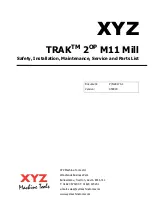
Viper SC+™ IP Router for Licensed Spectrum PN 001-5008-000 Rev. C
| Page 5
SETUP / COM port
Pin-Out
Contact Numbering
Contact
Signal Name
Signal Direction
8
Clear To Send (CTS)
(1)
DTE ← DCE
9
Ring Indicator (RI)
(3)
DTE ― DCE
(1)
Programmable
(2)
Always asserted
(3)
Future use
1.3.3.3.
Power Connector
Viper is supplied with a right-angle power connector (10-30 V DC). The following table shows the
pin-out of the power connector.
Table 5 – Pin-Out of the Power Connector
Power Connector
Pin-Out
Contact
number
(Left to Right)
Color
Description
4
Fan Power Output (5V)
3
Black
Ground
2
Red
Positive (10-30) VDC
1
White
Enable to Power Management — See
Note
Power – Viper is awake.
No Power – Viper is asleep.
See
for detailed voltage and current requirements.
Note:
The white Enable line must be tied to the red positive lead of the connector for the Viper to power up and
function.
WARNING – EXPLOSION HAZARD - Do not disconnect unless power has been removed or the area is
known to be non-hazardous.
1.3.3.4.
Antenna Connector
Standard Viper SC+ models have a 50 ohm TNC female antenna connector. This connection functions for
both transmit and receive.
Warning:
See Selecting Antenna and Lightning Arrestor combinations for information about types of lightning
arrestors to not use and good design practices to use when selecting a lightning arrestor for use with an antenna.
Dual port models feature a 50 ohm TNC female antenna connector functioning for transmit (only) and a 50
ohm SMA female antenna connector functioning for receive (only). The separate receive antenna connector is
ideal for applications that require additional receive filtering, external PA(s) and other options.
Warning:
The transmit antenna port must not be connected directly to the receive antenna port of the Dual Port
Viper SC+. Excessive power into the receive antenna port will damage the radio. Input power to the receiver should
not exceed 17 dBm (50 mW).
















































